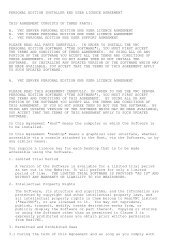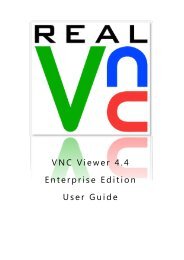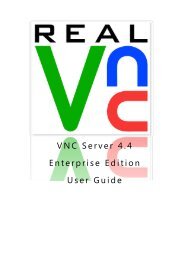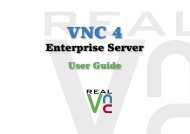VNC User Guide - RealVNC
VNC User Guide - RealVNC
VNC User Guide - RealVNC
You also want an ePaper? Increase the reach of your titles
YUMPU automatically turns print PDFs into web optimized ePapers that Google loves.
Chapter 6: Setting Up <strong>VNC</strong> Server<br />
Under UNIX/Linux and Mac OS X, however, there is another dimension to license scope. The license to use<br />
<strong>VNC</strong> Server not only applies to all computer users, but additionally limits the number of instances of <strong>VNC</strong><br />
Server that can start. For example, if your license entitles you to five ‘desktops’, attempting to start <strong>VNC</strong><br />
Server for a sixth time fails. For more information, visit www.realvnc.com/products/vnc/documentation/latest/<br />
licensing-faq/.<br />
Note: You can quickly see how many instances of <strong>VNC</strong> Server your license permits you to start, and how<br />
many of these are currently running. See page 80 for more information.<br />
Note you can start a maximum of five instances of <strong>VNC</strong> Server (Free) on UNIX/Linux and Mac OS X<br />
computers. Upgrade the host computer to <strong>VNC</strong> Server (Enterprise) or <strong>VNC</strong> Server (Personal) if flexibility is<br />
important to you.<br />
Starting <strong>VNC</strong> Server<br />
To start <strong>VNC</strong> Server, follow the appropriate instructions for the host computer’s platform below.<br />
Note: As soon as <strong>VNC</strong> Server is licensed and started, users can connect. To delay or prevent connections,<br />
see Preventing connections to <strong>VNC</strong> Server on page 92.<br />
Windows<br />
<strong>VNC</strong> Server can start in Service Mode, in <strong>User</strong> Mode, or both. For more information on these modes, which<br />
you might want to use, and why you might want to run more than one instance of <strong>VNC</strong> Server, see Running<br />
multiple instances of <strong>VNC</strong> Server on page 78.<br />
To start <strong>VNC</strong> Server:<br />
• In Service Mode, select Real<strong>VNC</strong> > <strong>VNC</strong> Server from the Start menu. Note administrative privileges are<br />
required to perform this operation.<br />
Note: By default, <strong>VNC</strong> Server automatically starts as a service when the computer is powered on. If you<br />
explicitly stop <strong>VNC</strong> Server, however, the service does not automatically restart when the computer is<br />
rebooted.<br />
• In <strong>User</strong> Mode, select Real<strong>VNC</strong> > Advanced > <strong>VNC</strong> Server (<strong>User</strong> Mode) from the Start menu.<br />
Note: Microsoft <strong>User</strong> Account Control severely restricts users connected to <strong>VNC</strong> Server in <strong>User</strong> Mode<br />
from fully controlling a host computer running Windows Vista or later.<br />
<strong>VNC</strong> <strong>User</strong> <strong>Guide</strong> 73
















